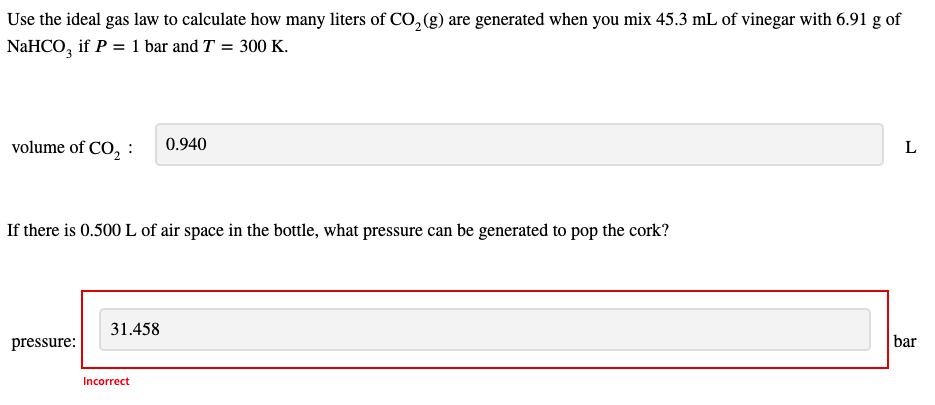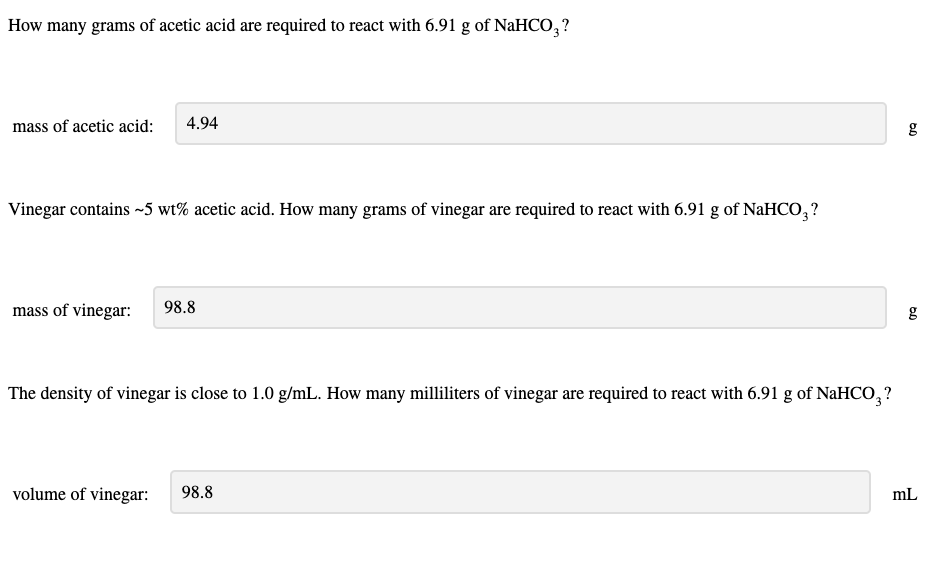A cork popper. To entertain children between the ages of 2 and 90, Daniel Harris enjoys popping corks from bottles containing vinegar and baking soda. He pours about 50 mL of vinegar into a 500‑mL plastic bottle. Then, he wraps about 5 g of baking soda (which is sodium bicarbonate, NaHCO3 in one layer of tissue and drops the tissue into the bottle. He places a cork tightly in the mouth of the bottle and steps back. The chemical reaction generates CO2(g) that pressurizes the bottle and eventually bursts the cork into the air. Everyone smiles. CH3CO2Hacetic acid in vinegar+NaHCO3sodium carbonatein baking soda⟶CH3CO−2+Na++CO2(g)+H2O Find the formula mass of acetic acid and of sodium bicarbonate. acetic acid formula mass: 60 g/mol sodium bicarbonate formula mass: 84 g/mol How many grams of acetic acid are required to react with 6.91 g of NaHCO3?
A cork popper. To entertain children between the ages of 2 and 90, Daniel Harris enjoys popping corks from bottles containing vinegar and baking soda. He pours about 50 mL of vinegar into a 500‑mL plastic bottle. Then, he wraps about 5 g of baking soda (which is sodium bicarbonate, NaHCO3 in one layer of tissue and drops the tissue into the bottle. He places a cork tightly in the mouth of the bottle and steps back. The chemical reaction generates CO2(g) that pressurizes the bottle and eventually bursts the cork into the air. Everyone smiles. CH3CO2Hacetic acid in vinegar+NaHCO3sodium carbonatein baking soda⟶CH3CO−2+Na++CO2(g)+H2O Find the formula mass of acetic acid and of sodium bicarbonate. acetic acid formula mass: 60 g/mol sodium bicarbonate formula mass: 84 g/mol How many grams of acetic acid are required to react with 6.91 g of NaHCO3?
Chemistry
10th Edition
ISBN:9781305957404
Author:Steven S. Zumdahl, Susan A. Zumdahl, Donald J. DeCoste
Publisher:Steven S. Zumdahl, Susan A. Zumdahl, Donald J. DeCoste
Chapter1: Chemical Foundations
Section: Chapter Questions
Problem 1RQ: Define and explain the differences between the following terms. a. law and theory b. theory and...
Related questions
Question
A cork popper. To entertain children between the ages of 2 and 90, Daniel Harris enjoys popping corks from bottles containing vinegar and baking soda. He pours about 50 mL of vinegar into a 500‑mL plastic bottle. Then, he wraps about 5 g of baking soda (which is sodium bicarbonate, NaHCO3 in one layer of tissue and drops the tissue into the bottle. He places a cork tightly in the mouth of the bottle and steps back. The
CH3CO2Hacetic acid in vinegar+NaHCO3sodium carbonatein baking soda⟶CH3CO−2+Na++CO2(g)+H2O
Find the formula mass of acetic acid and of sodium bicarbonate.
acetic acid formula mass: 60 g/mol
sodium bicarbonate formula mass: 84 g/mol
How many grams of acetic acid are required to react with 6.91 g of NaHCO3?
mass of acetic acid: 4.94 g

Transcribed Image Text:Use the ideal gas law to calculate how many liters of CO,(g) are generated when you mix 45.3 mL of vinegar with 6.91 g of
NaHCO, if P = 1 bar and T = 300 K.
volume of CO, :
0.940
If there is 0.500 L of air space in the bottle, what pressure can be generated to pop the cork?
31.458
pressure:
bar
Incorrect

Transcribed Image Text:How many grams of acetic acid are required to react with 6.91 g of NaHCO,?
mass of acetic acid:
4.94
g
Vinegar contains ~5 wt% acetic acid. How many grams of vinegar are required to react with 6.91 g of NaHCO,?
mass of vinegar:
98.8
The density of vinegar is close to 1.0 g/mL. How many milliliters of vinegar are required to react with 6.91 g of NaHCO, ?
volume of vinegar:
98.8
mL
Expert Solution
This question has been solved!
Explore an expertly crafted, step-by-step solution for a thorough understanding of key concepts.
This is a popular solution!
Trending now
This is a popular solution!
Step by step
Solved in 4 steps

Knowledge Booster
Learn more about
Need a deep-dive on the concept behind this application? Look no further. Learn more about this topic, chemistry and related others by exploring similar questions and additional content below.Recommended textbooks for you

Chemistry
Chemistry
ISBN:
9781305957404
Author:
Steven S. Zumdahl, Susan A. Zumdahl, Donald J. DeCoste
Publisher:
Cengage Learning

Chemistry
Chemistry
ISBN:
9781259911156
Author:
Raymond Chang Dr., Jason Overby Professor
Publisher:
McGraw-Hill Education

Principles of Instrumental Analysis
Chemistry
ISBN:
9781305577213
Author:
Douglas A. Skoog, F. James Holler, Stanley R. Crouch
Publisher:
Cengage Learning

Chemistry
Chemistry
ISBN:
9781305957404
Author:
Steven S. Zumdahl, Susan A. Zumdahl, Donald J. DeCoste
Publisher:
Cengage Learning

Chemistry
Chemistry
ISBN:
9781259911156
Author:
Raymond Chang Dr., Jason Overby Professor
Publisher:
McGraw-Hill Education

Principles of Instrumental Analysis
Chemistry
ISBN:
9781305577213
Author:
Douglas A. Skoog, F. James Holler, Stanley R. Crouch
Publisher:
Cengage Learning

Organic Chemistry
Chemistry
ISBN:
9780078021558
Author:
Janice Gorzynski Smith Dr.
Publisher:
McGraw-Hill Education

Chemistry: Principles and Reactions
Chemistry
ISBN:
9781305079373
Author:
William L. Masterton, Cecile N. Hurley
Publisher:
Cengage Learning

Elementary Principles of Chemical Processes, Bind…
Chemistry
ISBN:
9781118431221
Author:
Richard M. Felder, Ronald W. Rousseau, Lisa G. Bullard
Publisher:
WILEY